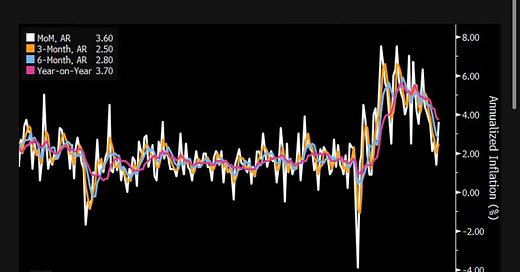Weekly Good Reads: 5-1-1
Growth, Treasury Market, Trade Flow, Bond Vigilantes, Health Insurance
Welcome to Weekly Good Reads 5-1-1 by Marianne O, an investment practitioner and author of
about investing, economy and wellness ideas. Every week I include 5 links to relevant economic and investment, finance and wellness/idea pursuit as well as 1 important chart and 1 term to know. All the Weeklies are here and here is the index of charts and terms. You can easily subscribe to my newsletter by clicking below.Thank you so much for reading and supporting my work 🙏.
Market and Data Comments
Major regions are heading in different directions in terms of growth. While US growth has been led by consumption, Europe’s PMI (a prevailing condition indicator) in both manufacturing and services showed a deterioration from September, with weakness broadening to the labour market. China has seen more fiscal easing, with the government announcing a RMB 1 trillion (about 0.8% of GDP) central government bond issuance to help local governments and support infrastructure spending.
The three major US economic news last week were: first, real GDP growth surged to 4.9% (annually) in Q3; however inventory was one-third of the headline growth. It looks like services spending and inventory accumulation will slow and trade will decline further, with Q4 GDP growth likely to be slightly negative. Large companies’ CEOs from various industries — banking, payments, logistics, technology and consumer discretionary — voiced similar cautiousness. See article by
under Economy and Investments.Second, US consumers increased spending by 0.7% in September, which exceeded income growth of 0.3%, while real disposable incomes declined for the fourth month in a row.
Third, headline PCE inflation surprisingly ticked up in September and the monthly core inflation growth picked up to 0.3% from 0.1% in August. Consumer inflation expectations also rose to 4.2%. With the Fed focusing on the disinflation trend in core inflation, the market expects the FOMC is still likely to pause in November.
For market actions, stocks continued to be down reflecting poorer sentiment and declining fundamentals/expectations in major stock markets. The S&P 500 entered into correction territory (-10.3%) by Friday last week. Only bonds (except Japan), Dollar, and Gold staged a rally last week. According to Datatrek, investment grade and high-yield corporate bond spreads have been climbing and are now above their 2017 to 2019 averages.
This coming week, we will monitor Japan’s interest rate decision and yield target on Tuesday, the FOMC and Fed Press Conference and China’s October Caixin manufacturing PMI on Wednesday, and the Bank of England rate decision on Thursday.
Economy and Investments (Links):
The Gems Hiding in Plain Sight in the Treasury Market (New York Times or click here)
Bitcoin and Gold Prices Set to Outperform Stocks in November —Key Indicators (FX Empire)
US GDP Grew 4.9% in Q3. But CEOs from 5 Industries Have Turned Cautious. Is this the Peak? (The Pragmatic Optimist)
Finance/Wealth (Link):
Understanding Investing Regime Change (The Big Picture)
+ America's Record Wealth Boom (Apricitas Economics)
Wellness/Idea (Link):
Why the US is the Only Country that Ties Your Health Insurance to Your Job? (Vox)
One Chart You Should Not Miss: (McKinsey)
As global trade continues to reconfigure and evolve, collaboration is critical to addressing sustainability in global trade.
McKinsey Global Institute's new interactive tool — Global Trade Explorer — which draws on 20 years worth of data covering more than 50 economies, 15 major sectors, and 100 subsectors across various manufactured goods and resources categories—can be useful for decision-making around growth opportunities, supply chain dynamics, and other trends that depend on global trade flows.

One Term To Know: Bond Vigilantes
Bond Vigilantes refer to bond market investors who protest against monetary or fiscal policy they fear is inflationary. These bond investors more generally push back against certain policies undertaken by the issuer. As a result, bond yields are pushed up. This demonstrates bond holders in concerted action can exert a large influence over the borrowers.
The term originated in the 1980s when bond traders protested the Federal Reserve’s dovish monetary policy.
In the U.S. the 10-year government bond has recently pushed past 5% and the government announced recently that the budget deficit ending September 2023 reached $1.7 trillion, a 24% jump from the last fiscal year. Reason: slumping tax receipts, rising interest rates and persistent demand for expiring pandemic relief benefits (e.g. employee retention credit) strained the nation’s finances (NYT).
The Congressional Budget Office projected interest expenditures on the national debt would be the US government’s largest expenditure by 2053.
When will bond vigilantes stop? Not until inflation calms and the budget deficit is reined in.
Please do not hesitate to get in touch if you have any questions! If you like this weekly, please share it with your friends or subscribe to my newsletter.







The Global Trade Explorer is such a powerful tool. I need to integrate it more in my work and analysis. Thanks for pointing it out.